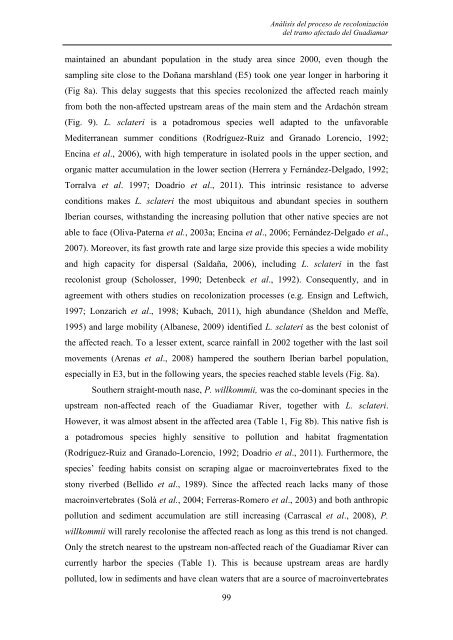las comunidades de peces del río guadiamar y el accidente minero ...
las comunidades de peces del río guadiamar y el accidente minero ...
las comunidades de peces del río guadiamar y el accidente minero ...
Create successful ePaper yourself
Turn your PDF publications into a flip-book with our unique Google optimized e-Paper software.
Análisis <strong>de</strong>l proceso <strong>de</strong> recolonización<br />
<strong>de</strong>l tramo afectado <strong>de</strong>l Guadiamar<br />
maintained an abundant population in the study area since 2000, even though the<br />
sampling site close to the Doñana marshland (E5) took one year longer in harboring it<br />
(Fig 8a). This <strong>de</strong>lay suggests that this species recolonized the affected reach mainly<br />
from both the non-affected upstream areas of the main stem and the Ardachón stream<br />
(Fig. 9). L. sclateri is a potadromous species w<strong>el</strong>l adapted to the unfavorable<br />
Mediterranean summer conditions (Rodríguez-Ruiz and Granado Lorencio, 1992;<br />
Encina et al., 2006), with high temperature in isolated pools in the upper section, and<br />
organic matter accumulation in the lower section (Herrera y Fernán<strong>de</strong>z-D<strong>el</strong>gado, 1992;<br />
Torralva et al. 1997; Doadrio et al., 2011). This intrinsic resistance to adverse<br />
conditions makes L. sclateri the most ubiquitous and abundant species in southern<br />
Iberian courses, withstanding the increasing pollution that other native species are not<br />
able to face (Oliva-Paterna et al., 2003a; Encina et al., 2006; Fernán<strong>de</strong>z-D<strong>el</strong>gado et al.,<br />
2007). Moreover, its fast growth rate and large size provi<strong>de</strong> this species a wi<strong>de</strong> mobility<br />
and high capacity for dispersal (Saldaña, 2006), including L. sclateri in the fast<br />
recolonist group (Scholosser, 1990; Detenbeck et al., 1992). Consequently, and in<br />
agreement with others studies on recolonization processes (e.g. Ensign and Leftwich,<br />
1997; Lonzarich et al., 1998; Kubach, 2011), high abundance (Sh<strong>el</strong>don and Meffe,<br />
1995) and large mobility (Albanese, 2009) i<strong>de</strong>ntified L. sclateri as the best colonist of<br />
the affected reach. To a lesser extent, scarce rainfall in 2002 together with the <strong>las</strong>t soil<br />
movements (Arenas et al., 2008) hampered the southern Iberian barb<strong>el</strong> population,<br />
especially in E3, but in the following years, the species reached stable lev<strong>el</strong>s (Fig. 8a).<br />
Southern straight-mouth nase, P. willkommii, was the co-dominant species in the<br />
upstream non-affected reach of the Guadiamar River, together with L. sclateri.<br />
However, it was almost absent in the affected area (Table 1, Fig 8b). This native fish is<br />
a potadromous species highly sensitive to pollution and habitat fragmentation<br />
(Rodríguez-Ruiz and Granado-Lorencio, 1992; Doadrio et al., 2011). Furthermore, the<br />
species’ feeding habits consist on scraping algae or macroinvertebrates fixed to the<br />
stony riverbed (B<strong>el</strong>lido et al., 1989). Since the affected reach lacks many of those<br />
macroinvertebrates (Solà et al., 2004; Ferreras-Romero et al., 2003) and both anthropic<br />
pollution and sediment accumulation are still increasing (Carrascal et al., 2008), P.<br />
willkommii will rar<strong>el</strong>y recolonise the affected reach as long as this trend is not changed.<br />
Only the stretch nearest to the upstream non-affected reach of the Guadiamar River can<br />
currently harbor the species (Table 1). This is because upstream areas are hardly<br />
polluted, low in sediments and have clean waters that are a source of macroinvertebrates<br />
99

















